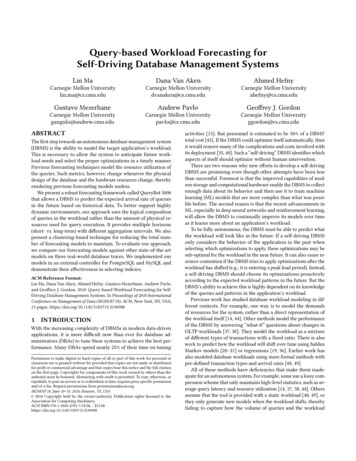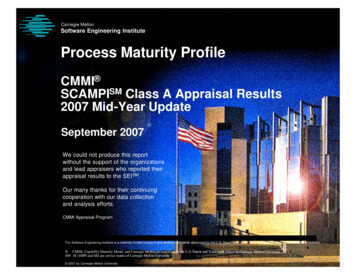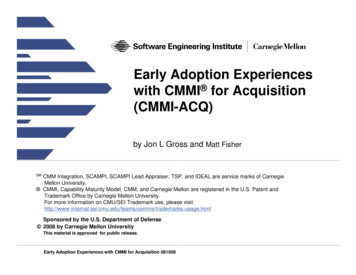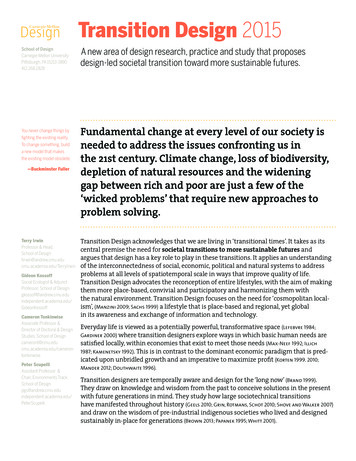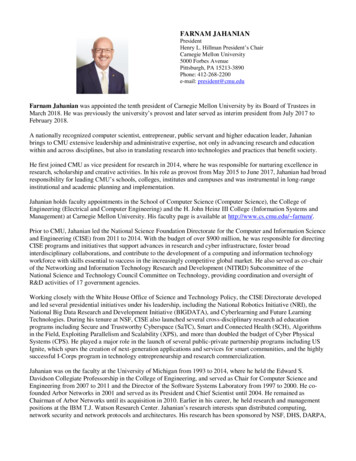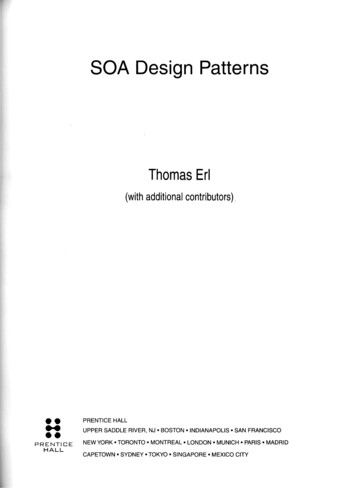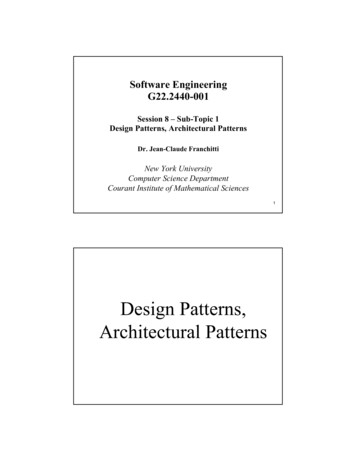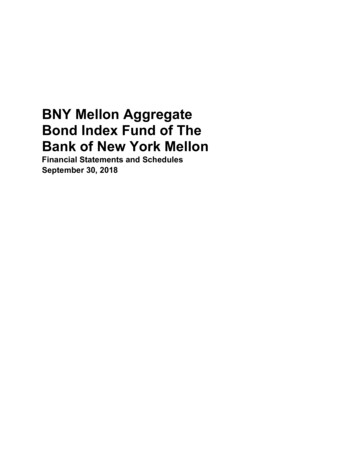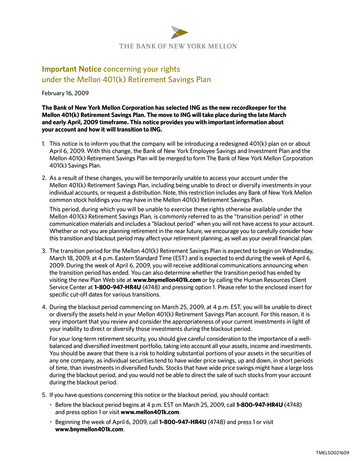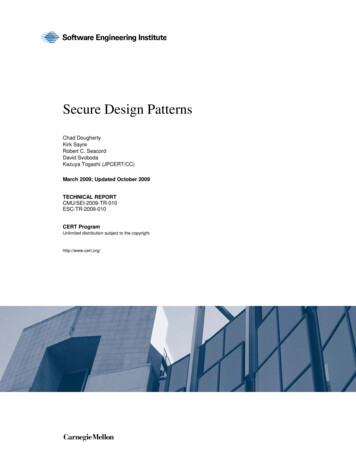
Transcription
Secure Design PatternsChad DoughertyKirk SayreRobert C. SeacordDavid SvobodaKazuya Togashi (JPCERT/CC)March 2009; Updated October 2009TECHNICAL REPORTCMU/SEI-2009-TR-010ESC-TR-2009-010CERT ProgramUnlimited distribution subject to the copyright.http://www.cert.org/
This report was prepared for theSEI Administrative AgentESC/XPK5 Eglin StreetHanscom AFB, MA 01731-2100The ideas and findings in this report should not be construed as an official DoD position. It is published in theinterest of scientific and technical information exchange.This work is sponsored by the U.S. Department of Defense. The Software Engineering Institute is a federallyfunded research and development center sponsored by the U.S. Department of Defense.Copyright 2009 Carnegie Mellon University.NO WARRANTYTHIS CARNEGIE MELLON UNIVERSITY AND SOFTWARE ENGINEERING INSTITUTE MATERIAL ISFURNISHED ON AN "AS-IS" BASIS. CARNEGIE MELLON UNIVERSITY MAKES NO WARRANTIES OFANY KIND, EITHER EXPRESSED OR IMPLIED, AS TO ANY MATTER INCLUDING, BUT NOT LIMITEDTO, WARRANTY OF FITNESS FOR PURPOSE OR MERCHANTABILITY, EXCLUSIVITY, OR RESULTSOBTAINED FROM USE OF THE MATERIAL. CARNEGIE MELLON UNIVERSITY DOES NOT MAKEANY WARRANTY OF ANY KIND WITH RESPECT TO FREEDOM FROM PATENT, TRADEMARK, ORCOPYRIGHT INFRINGEMENT.Use of any trademarks in this report is not intended in any way to infringe on the rights of the trademark holder.Internal use. Permission to reproduce this document and to prepare derivative works from this document for internal use is granted, provided the copyright and "No Warranty" statements are included with all reproductions andderivative works.External use. Requests for permission to reproduce this document or prepare derivative works of this document forexternal and commercial use should be directed to permission@sei.cmu.edu.This work was created in the performance of Federal Government Contract Number FA8721-05-C-0003 withCarnegie Mellon University for the operation of the Software Engineering Institute, a federally funded researchand development center. The Government of the United States has a royalty-free government-purpose license touse, duplicate, or disclose the work, in whole or in part and in any manner, and to have or permit others to do so,for government purposes pursuant to the copyright license under the clause at 252.227-7013.For information about purchasing paper copies of SEI reports, please visit the publications section of our website(http://www.sei.cmu.edu/publications/).
Table of ContentsAcknowledgmentsvAbstractvi1Introduction1.1 About Secure Design Patterns1.2 Purpose1.3 Scope1.4 Format and Conventions1.5 October 2009 Update1123452The Architectural-Level Patterns2.1 Distrustful Decomposition2.2 PrivSep (Privilege Separation)2.3 Defer to Kernel669163The Design-Level Patterns3.1 Secure Factory26263.23.1.1 Intent3.1.2 Motivation (Forces)3.1.3 Applicability3.1.4 Structure3.1.5 Participants3.1.6 Consequences3.1.7 Implementation3.1.8 Sample Code3.1.9 Known UsesSecure Strategy Factory262627272728282929293.33.2.1 Intent3.2.2 Motivation (Forces)3.2.3 Applicability3.2.4 Structure3.2.5 Participants3.2.6 Consequences3.2.7 Implementation3.2.8 Sample Code3.2.9 Known UsesSecure Builder Factory292930303132323238383.43.3.1 Intent3.3.2 Motivation (Forces)3.3.3 Applicability3.3.4 Structure3.3.5 Participants3.3.6 Consequences3.3.7 Implementation3.3.8 Sample Code3.3.9 Known UsesSecure Chain of tentMotivation (Forces)i CMU/SEI-2009-TR-010
3.53.6453.4.3 Applicability3.4.4 Structure3.4.5 Participants3.4.6 Consequences3.4.7 Implementation3.4.8 Sample Code3.4.9 Known UsesSecure State MachineSecure VisitorThe Implementation-Level Patterns4.1 Secure Logger4.24.1.1 Intent4.1.2 Motivation (Forces)4.1.3 Applicability4.1.4 Structure4.1.5 Participants4.1.6 Consequences4.1.7 Implementation4.1.8 Sample Code4.1.9 Known UsesClear Sensitive Information4.34.44.54.64.2.1 Intent4.2.2 Motivation (Forces)4.2.3 Applicability4.2.4 Structure4.2.5 Participants4.2.6 Consequences4.2.7 Implementation4.2.8 Sample Code4.2.9 Known UsesSecure DirectoryPathname CanonicalizationInput ValidationResource Acquisition Is Initialization (RAII)Conclusion and Future Work5.1 Conclusion5.2 Future WorkReferencesii 67676778182828282828383838490909496102106106106107
List of FiguresFigure 1:General Structure of the Distrustful Decomposition Secure Design Pattern7Figure 2:Structure of the Qmail Mail System8Figure 3:Vulnerable ftpd Program9Figure 4:OpenSSH PrivSep Implementation10Figure 5:General Structure of the Defer to Kernel Pattern18Figure 6:Example Structure of Defer to Kernel Pattern18Figure 7:Secure Factory Pattern Structure27Figure 8:Secure Strategy Factory Pattern Structure30Figure 9:Secure Builder Factory Pattern Structure40Figure 10:Secure Chain of Responsibility Pattern Example49Figure 11:Secure Chain of Responsibility Pattern Structure50Figure 12:Secure State Machine Pattern Structure58Figure 13:Secure State Machine Example Code Collaboration Diagram60Figure 14:Secure Visitor Pattern Structure70Figure 15:Secure Visitor Example Code Collaboration Diagram72Figure 16:Secure Logger Pattern Structure75Figure 17:Clear Sensitive Information Pattern Structure83Figure 18:Structure of the Input Validation Pattern97iii CMU/SEI-2009-TR-010
List of TablesTable 1:Pattern Elementsiv CMU/SEI-2009-TR-0104
AcknowledgmentsThanks to our sponsor, JPCERT/CC. Thanks to our SEI editors Pamela Curtis and Amanda Parente, and to Yurie Ito and Bob Rosenstein for making this work possible.v CMU/SEI-2009-TR-010
AbstractThe cost of fixing system vulnerabilities and the risk associated with vulnerabilities after systemdeployment are high for both developers and end users. While there are a number of best practicesavailable to address the issue of software security vulnerabilities, these practices are often difficultto reuse due to the implementation-specific nature of the best practices. In addition, greater understanding of the root causes of security flaws has led to a greater appreciation of the importance oftaking security into account in all phases in the software development life cycle, not just in theimplementation and deployment phases. This report describes a set of secure design patterns,which are descriptions or templates describing a general solution to a security problem that can beapplied in many different situations. Rather than focus on the implementation of specific securitymechanisms, the secure design patterns detailed in this report are meant to eliminate the accidental insertion of vulnerabilities into code or to mitigate the consequences of vulnerabilities. Thepatterns were derived by generalizing existing best security design practices and by extendingexisting design patterns with security-specific functionality. They are categorized according totheir level of abstraction: architecture, design, or implementation.vi CMU/SEI-2009-TR-010
1 Introduction1.1 About Secure Design PatternsA pattern is a general reusable solution to a commonly occurring problem in design. Note that adesign pattern is not a finished design that can be transformed directly into code. It is a description or template for how to solve a problem that can be used in many different situations. Algorithms are not thought of as design patterns because they solve computational problems ratherthan design problems.Secure design patterns are meant to eliminate the accidental insertion of vulnerabilities into codeand to mitigate the consequences of these vulnerabilities. In contrast to the design-level patternspopularized in [Gamma 1995], secure design patterns address security issues at widely varyinglevels of specificity ranging from architectural-level patterns involving the high-level design ofthe system down to implementation-level patterns providing guidance on how to implement portions of functions or methods in the system.1.1.1Pattern History1977/79 – Architect Christopher Alexander introduced the concept of design patterns with respectto the design of buildings and towns [Alexander 1977].1987 – Beck and Cunningham experimented with applying patterns to programming and presented at OOPSLA [Beck 1987].1994/95 – The “Gang of Four” (Erich Gamma, Richard Helm, Ralph Johnson, and John M. Vlissides) published a book containing a large number of design-level patterns aimed at objectoriented programming languages [Gamma 1995].1997 – Yoder and Baraclow published a paper outlining several security patterns [Yoder 1997].1.1.2ResourcesA significant amount of research has already been performed in the field of security patterns. Thissection lists some of the major contributions to the field and provides a brief description of eachpiece of work. Security Design Patterns, Part 1 [Romanosky 2001]. The patterns in this report address highlevel security concerns, such as how to handle communication with untrusted third-party systems and the importance of multi-layered security. In addition, the patterns in this report address high-level process issues such as the use of white-hat penetration testing and addressing simple, high-impact security issues early in the system development and configurationprocess. Core Security Patterns Book [Steel 2005]. This book concentrates on security patterns forJ2SE, J2EE, J2ME, and Java Card platform applications. The patterns contained in this bookare generally design-level patterns applicable primarily to Java web applications.1 CMU/SEI-2009-TR-010
Security Patterns: Integrating Security and Systems Engineering [Schumacher 2006]. Thisbook contains a large number of patterns at varying levels of specificity. The patterns in thisbook range from high-level patterns involving the processes used to develop secure systemsto design-level patterns addressing how to create objects with different access privileges. Open Group Guide to Security Patterns [Blakely 2004]. This report contains architecturallevel patterns and design-level patterns focusing on system availability and the protection ofprivileged resources. The patterns presented in this report are general patterns applicable tosystems programmed in many different languages. Security Patterns Repository [Kienzle 2003]. This report contains both design-level patternsapplicable to designing and building secure applications and procedural patterns that are applicable to the process of designing, building, and configuring secure applications.1.2 Purpose1.2.1Problem to Be SolvedThe cost of fixing system vulnerabilities and the risk associated with vulnerabilities after systemdeployment are high for both developers and end users. Steps to reduce the cost of system maintenance and the risk of security vulnerabilities need to be adopted by software development organizations. While there are a number of best practices available to address the issue of softwaresecurity vulnerabilities, these practices are frequently difficult to reuse due to the implementationspecific nature of the best practices. In addition, greater understanding of the root causes of security flaws has led to a greater appreciation of the importance of taking security into account in allphases in the software development life cycle, not just in the implementation and deploymentphases. Many current best security practices focus on implementation and deployment issues andso do not address security flaws introduced in earlier phases of the development process.Various secure design patterns detailed in this report address security issues in the architecturaldesign, detailed design, and implementation phases of the software development life cycle. In addition, several of the presented patterns were created by analyzing and generalizing existing,proven best practices. Some potential new secure design patterns, created by extending existingdesign patterns to take security issues into account, are also proposed in this report.The creation of secure design patterns by generalizing and cataloging existing best practices andby the extension of existing non-secure design patterns benefits the developers of secure softwareproducts. By using reusable security patterns, developers can reduce the cost associated with producing secure products while at the same time reducing the cost and the risk associated with security vulnerabilities for both developers and end users.1.2.2ApproachThe approach taken to define the patterns in this document is to capture a number of demonstrably security-effective techniques from existing designs thatcan and should be replicated in other systems distill and document these techniques as secure design patterns2 CMU/SEI-2009-TR-010
Additionally, several new but unproven patterns are proposed in this document. These patterns aresecure extensions of some well-known patterns described in [Gamma 1995].Inspirations for the patterns in this document include OpenBSD-derived projects qmail and Postfix mail system designs relevant recommendations from Kernighan and Pike’s The Practice of Programming [Kernighan 1999] well-known basic design patterns from [Gamma 1995]1.2.3Intended AudienceThe intended audience of this report is software engineers producing software artifacts at varyinglevels of abstraction, including architecture, design, and implementation.The secure patterns in this report are grouped accordingly.1.3 ScopeSecure design patterns, as described by this report, provide general design guidance to eliminatethe introduction of vulnerabilities into code or mitigate the consequences of vulnerabilities. Secure design patterns are not restricted to object-oriented design approaches but may also be applied, in many cases, to procedural languages. These patterns are at a higher level of abstractionthan secure coding guidelines.Secure design patterns differ from security patterns in that they do not describe specific securitymechanisms (such as access control, authentication, and authorization (AAA) and logging), definesecure development processes, or provide guidance on the configuration of existing secure systems.Three general classes of patterns are presented in this document: Architectural-level patterns. Architectural-level patterns focus on the high-level allocation ofresponsibilities between different components of the system and define the interaction betweenthose high-level components. The architectural-level patterns defined in this document are Distrustful Decomposition PrivSep (Privilege Separation) Defer to Kernel Design-level patterns. Design-level patterns describe how to design and implement piecesof a high-level system component, that is, they address problems in the internal design of asingle high-level component, not the definition and interaction of high-level componentsthemselves. The design-level patterns defined in this document are Secure Factory Secure Strategy Factory Secure Builder Factory Secure Chain of Responsibility Secure State Machine Secure Visitor3 CMU/SEI-2009-TR-010
Implementation-level patterns. Implementation-level patterns address low-level securityissues. Patterns in this class are usually applicable to the implementation of specific functions or methods in the system. Implementation-level patterns address the same problem setaddressed by the CERT Secure Coding Standards [CERT 2009a] and are often linked to acorresponding secure coding guideline. Implementation-level patterns defined in this document are Secure Logger Clear Sensitive Information Secure Directory Pathname Canonicalization Input Validation Resource Acquisition Is InitializationThis report does not provide a complete secure design pattern catalog. In the creation of this report, some, but by no means all, best practices used in the creation of secure software were analyzed and generalized.1.4 Format and ConventionsThe template for describing design patterns used in [Gamma 1995] was used to describe the secure design patterns in this report. The sections in the template are shown in Table 1. Sectionswhose names are italicized are optional.Table 1:Pattern ElementsElementDescriptionIntentThe problem solved by the design pattern and its general rationale and purpose.Also Known AsOther names for the pattern, if any are known.ExampleA real-world example demonstrating the existence of the problem and the need for thepattern. Throughout the description, we refer to examples to illustrate solutions andimplementation aspects, where this is necessary or useful.MotivationA description of situations in which the pattern may apply and a more detailed description of the problem that the pattern is intended to solve.ApplicabilityA general description of the characteristics a program must have for the pattern to beuseful in the design or implementation of the program.StructureA textual or graphical description of the relationship between the various participantsin the pattern. This provides a detailed specification of the structural aspects of thepattern, using appropriate notations.ParticipantsThe entities involved in the pattern.ConsequencesThe benefits the pattern provides and any potential liabilities.ImplementationGuidelines for implementing the pattern. These are only a suggestion, not an immutable rule. You should adapt the implementation to meet your needs by adding different,extra, or more detailed steps or by reordering the steps. Whenever applicable we giveUML fragments to illustrate a possible implementation, often describing details of theexample problem.Sample CodeCode providing an example of how to implement the pattern.Example ResolvedAn example of how the real-world example problem described in the Example sectionmay be resolved through the use of the secure design pattern.Known UsesExamples of the use of the pattern, taken from existing systems.4 CMU/SEI-2009-TR-010
1.5 October 2009 UpdateSix secure design patterns were added to this report in the October 2009 update: Secure Factory (Section 3.1) Secure Strategy Factory (Section 3.2) Secure Builder Factory (Section 3.3) Secure Chain of Responsibility (Section 3.4) Secure Logger (Section 4.1) Clear Sensitive Information (Section 4.2)5 CMU/SEI-2009-TR-010
2 The Architectural-Level Patterns2.1 Distrustful Decomposition2.1.1IntentThe intent of the Distrustful Decomposition secure design pattern is to move separate functionsinto mutually untrusting programs, thereby reducing the attack surface of the individual programs that make up the system functionality and data exposed to an attacker if one of the mutually untrusting programs iscompromised2.1.2Also Known AsPrivilege reduction2.1.3MotivationMany attacks target vulnerable applications running with elevated permissions. This allows theattacker to access more information and/or allows the attacker to perform more damage after exploiting a security hole in the application than if the application had been running with more restrictive permissions. Some examples of this class of attack are various attacks in which Internet Explorer running in an account with administrator privileges is compromised security flaws in Norton AntiVirus 2005 that allow attackers to run arbitrary VBS scriptswhen running with administrator privileges a buffer overflow vulnerability in BSD-derived telnet daemons that allows an attacker to runarbitrary code as rootAll of these attacks take advantage of security flaw(s) in an application running with elevated privileges (root under UNIX or administrator under Windows) to compromise the application andthen use the application’s elevated privileges and basic functionality to compromise other applications running on the computer or to access sensitive data. The Distrustful Decomposition patternisolates security vulnerabilities to a small subset of a system such that compromising a singlecomponent of the system does not lead to the entire system being compromised. The attacker willonly have the functionality and data of the single compromised component at their disposal formalicious activity, not the functionality and data of the entire application.2.1.4ApplicabilityThis pattern applies to systems where files or user-supplied data must be handled in a number ofdifferent ways by programs running with varying privileges and responsibilities. A naive implementation of this system may allocate many disparate functions to the same program, forcing theprogram to be run at the privilege level required by the program function requiring the highestprivilege level. This provides a large attack surface for attackers and leaves an attacker withaccess to a system with a high privilege level if the system is compromised.6 CMU/SEI-2009-TR-010
A system can make use of the Distrustful Decomposition pattern if the system performs more than one high-level function the various functions of the system require different privilege levels2.1.5StructureThe general structure of this pattern breaks the system up into two or more programs that run asseparate processes, with each process potentially having different privileges. Each process handlesa small, well-defined subset of the system functionality. Communication between processes occurs using an inter-process communication mechanism such as RPC, sockets, SOAP, or sharedfiles.Figure 1: General Structure of the Distrustful Decomposition Secure Design Pattern2.1.6ParticipantsThese are the participants in the Distrustful Decomposition pattern: a number of separate programs, each running in a separate process. For more complete separation, each process could have a unique user ID that does not share any privileges with theother user IDs. a local user or a remote system connecting over a network possibly the system’s file system possibly an inter-process communication mechanism such as UNIX domain sockets, RPC, orSOAP2.1.7ConsequencesDistrustful Decomposition prevents an attacker from compromising an entire system in the eventthat a single component program is successfully exploited because no other program trusts theresults from the compromised one.2.1.8ImplementationThis pattern employs nothing beyond the standard process/privilege model already existing in theoperating system. Each program runs in its own process space with potentially separate user privileges. Communication between separate programs is either one-way or two-way. One-way. Only fork()/exec() (UNIX/Linux/etc.), CreateProcess() (Windows Vista),or some other OS-specific method of programmatic process creation is used to transfer control. One-way communication reduces the coupling between processes, making it more diffi-7 CMU/SEI-2009-TR-010
cult for an attacker to compromise one system component from another, already compromised component. Two-way. A two-way inter-process communication mechanism like TCP or SOAP is used.Extra care must be taken when using a two-way communication mechanism because it ispossible for one process involved in the two-way communication to be compromised andunder the control of an attacker. As with the file system, two-way communication should notbe inherently trusted.The file system may be a means of interaction, but no component places any inherent trust in thecontents of the file.2.1.9Sample CodeAn excellent example system where this pattern is applied is the qmail mail system, which is acomplex system with a large combination of interactions between systems, users, and softwarecomponents.The overall structure of the qmail system is shown in Figure 2 [Oppermann 1998].Figure 2: Structure of the Qmail Mail System11Source: 03-p1.gif. Used with permission from the author.8 CMU/SEI-2009-TR-010
The actual source code for the qmail system is omitted here; see the qmail website [Bernstein2008] for examples.2.1.10Known Uses The qmail mail system [Bernstein 2008]. The Postfix mail system uses a similar pattern [Postfix]. Microsoft mentions this general pattern when discussing how to run applications with administrator privileges [MSDN 2009b]. Distrustful decomposition for Windows Vista applications using user account control (UAC)is explicitly addressed in [Massa 2008].2.2 PrivSep (Privilege Separation)2.2.1IntentThe intent of the PrivSep pattern is to reduce the amount of code that runs with special privilegewithout affecting or limiting the functionality of the program. The PrivSep pattern is a more specific instance of the Distrustful Decomposition pattern.2.2.2MotivationIn many applications, a small set of simple operations require elevated privileges, while a muchlarger set of complex and security error-prone operations can run in the context of a normal unprivileged user. For a more detailed discussion of the motivation for using this pattern, please seethe motivation for the more general Distrustful Decomposition pattern.Figure 3 provides a detailed view of a system where the PrivSep pattern could be applied and thesecurity problems that can occur if the PrivSep pattern is not used [Provos 2003]. An implementation of ftpd is used as an example.Figure 3: Vulnerable ftpd Program9 CMU/SEI-2009-TR-010
The security flaw occurs when the privileged server establishes a connection with the as-yet untrusted system user and attempts to authenticate the user with a child possessing the same elevatedprivileges as the server. A malicious user could at this point exploit security holes in the privileged child and gain control of or access to a process with elevated privileges.2.2.3ApplicabilityIn general, this pattern is applicable if the system performs a set of functions that do not require elevated privileges have relatively large attack surfaces in that the functions have significant communication with untrusted sourcesmake use of complex, potentially error-prone algorithmsIn particular, this pattern is especially useful for system services that must authenticate users andthen allow the users to run interactive programs with normal, user-level privileges. It may be alsobe useful for other authenticating services.2.2.4StructureFigure 4 shows the structure and behavior of the PrivSep pattern. Note that this diagram makesreference to the UNIX fork() function for creating child processes. When implementing thePrivSep pattern in a non-UNIX-based OS, a different, OS-specific function would be used inplace of fork(). For example, under various versions of Windows, the CreateProcess() function is used to spawn a child process.Figure 4: OpenSSH PrivSep Implementation22Source: http://www.citi.umich.edu/u/provos/ssh/priv.jpg.10 CMU/SEI-2009-TR-010
2.2.5ParticipantsPrivileged Server ProcessThe privileged server process is responsible for fielding the initial requests for functionality thatwill eventually be handled by a child process with non-elevated privileges. The privileged serverhas an associated privileged userid (often root under UNIX-derived OSs, or administratorunder various versions of Windows).System UserThe system user asks the system to perform some action. This initial request for functionality isdirected by the user to the privileged server. The user can be local or remote. The user can communicate with the privileged server via an inter-process communication mechanism such as sockets or SOAP.Unprivileged Client ProcessThe unprivileged client is responsible for handling the authentication of the user’s request. Because it is not yet known if this is a valid request from a trusted user, the privileges of the childprocess handling authentication are limited as follows: The child process is given the minimal set of privileges allowed by the host OS. Under theUNIX privilege model, this is implemented by setting the user ID (UID) of the process to anunprivileged user ID. The root directory of the child process is set to an unimportant, empty directory or a jail[Seacord 2008]. This prevents the untrusted child process from accessing any of the files onthe machine running the untrusted child.User-Privileged Client ProcessOnce the system user and their request have been authorized, a child process with appropriate user-level privileges is spawned from the privileged server. The user-privileged child process actually handles the system user’s request. The user-privileged child has its UID set to a local user ID.2.2.6 ConsequencesAn adversary who gains control over the child is confined in its protection domain and does not gain control over the parent does not gain control of a process possessing elevated privileges, thereby limiting thedamage that the adversary can inflictAdditional verification, such as code reviews, additional testing, and formal verificationtechniques, can be focused on code that is executed with special privilege, which can furtherreduce the incidence of unauthorized privilege escalation.System administration overhead is usually increased to accommodate the management ofnew unprivileged user IDs.2.2.7ImplementationThe PrivSep pattern consists of two phases, pre-authentication and post-authentication.11 CMU/SEI-2009-TR-010
Pre-authentication. A user has contacted a system service but is not yet authenticated; theunprivileged child has no process privileges and no rights to access the file system.The pre-authentication stage is implemented using two entities: a privileged parent processthat acts as the monitor and an unprivileged child process that acts as the slave. The privileged parent can be modeled by a finite-state machine (FSM) that monitors the progress ofthe unprivileged child. Post-authentication. The user has successfully authenticated to the system. The child hasthe privileges of the user, including file system access, but does not hold any other specialprivilege.The general process implemented in the PrivSep pattern is as follows:1. Create a privileged server. Initial user requests will be directed to this server.2.When a user request arrives at the server, the server will sp
This work was created in the performance of Federal Government Contract Number FA8721-05-C-0003 with Carnegie Mellon University for the operation of the Software Engineering Institute, a federally funded research and development center. The Government of the United States has a royalty-free government-purpose license to . 1.1 About Secure .
